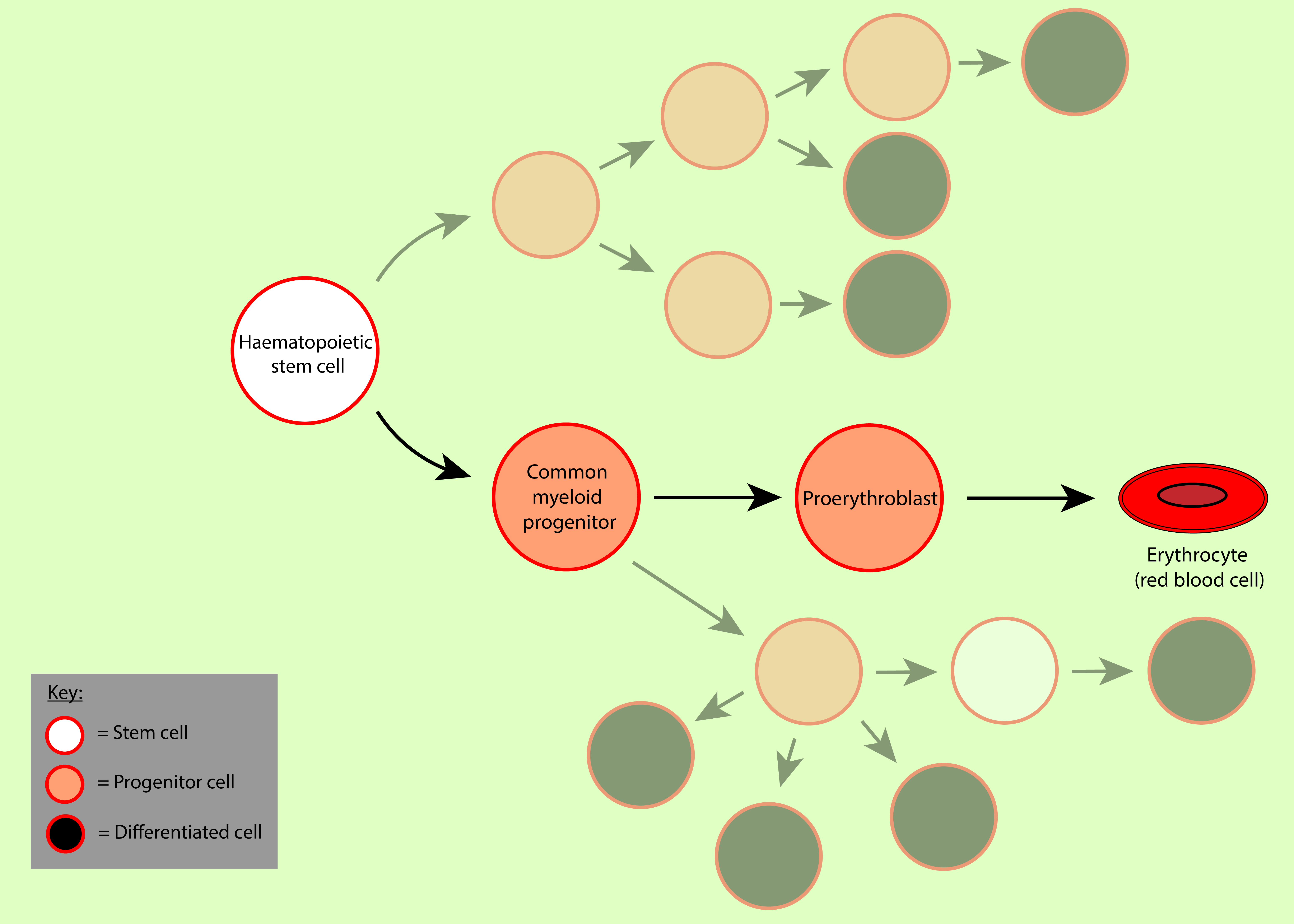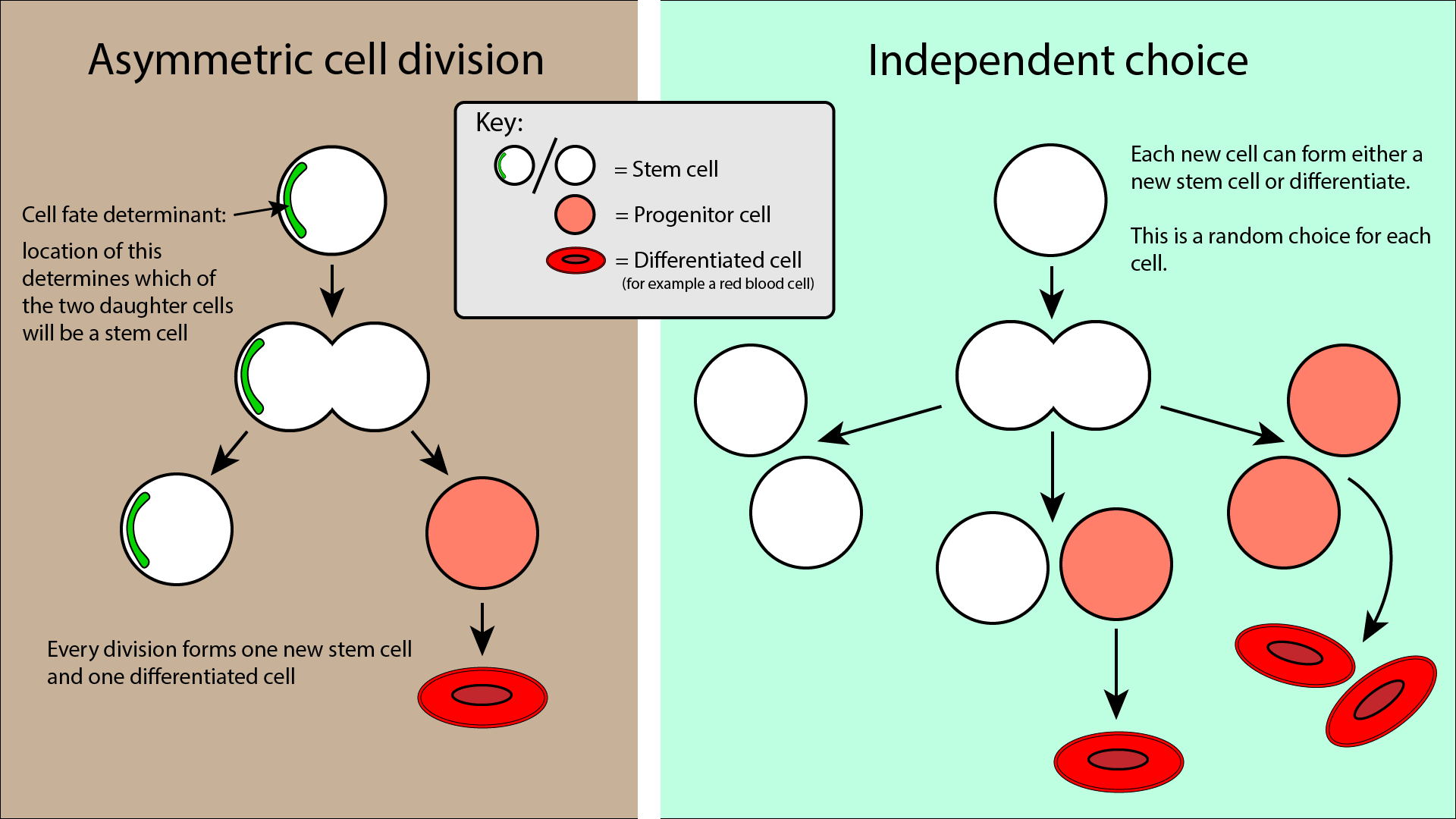Stem cells
Stem cells are unspecialised cells which have the potential to become a number of different cell types through a process known as differentiation. They play a key role in both development (embryonic stem cells) and maintenance (adult stem cells) of a healthy body. The ability to differentiate into different cell types suggests great therapeutic potential, for example in replacement of damaged or dysfunctional cells and tissues. In some organisms (such as newts), stem cells can even replace whole organs and limbs. On the other hand, some types of stem cells also play a role in the development and recurrence of malignancies.
There have already been some successes in the use of stem cells in the treatment of human diseases such as some forms of leukaemia, where healthy stem cells found in blood (haematopoietic stem cells) play a role as an important treatment modality. As powerful tools for tissue restoration and maintenance, manipulation of stem cells could have applications in many other aspects of disease management and treatment. In oral and maxillofacial surgery, several promising applications have been identified, for example in the repair of clefts and other major defects. Before we discuss a number of these attractive future targets for stem cell treatments and other key aspects of stem cells, we briefly sketch some key properties and types of stem cells below.
Key properties of stem cells
Lack of specialisation is one of the key properties of stem cells, along with their ability to be converted (differentiate) into a variety of cell types. Differentiation usually occurs in steps, forming a series of cells which have committed to the differentiation process, but are yet to fully specialise and can often differentiate into a variety of different cells themselves (known as ‘progenitor cells’). An example is the series of progenitor cells required before finally forming a red blood cell (Figure 1).

Potency of stem cells is a measure of their ability to differentiate into different cell types:
- totipotent stem cells can form any living tissue or even whole organisms;
- pluripotent stem cells can form any living tissue but not whole organisms, as they cannot form the supportive tissues for embryos (the placenta and the umbilical cord);
- multipotent stem cells are able to form a limited number of cell types, usually related to the area of the body in which these stem cells reside.
Totipotent and pluripotent stem cells are found in early human development. After fertilisation of egg cells, the cells are very briefly totipotent, only up to the stage where we are made of four cells. Cells from a specific part of the blastocyst, a structure found before embryo formation, are pluripotent (see below). Stem cells found in adult tissue are multipotent (Figure 2).

Self-renewal is another key stem cell property, the ability to divide to form more stem cells. There are different models of how stem cell division occurs, and it is thought that different models apply to different organs. In the ‘asymmetric division’ model, a stem cell divides to form one other stem cell, and one cell that will go on to differentiate. In the ‘independent choice’ model, each daughter cell could become either a stem cell or a differentiated cell (Figure 3). On a more philosophical note, the ability of self-renewal is actually the crucial aspect of a widely accepted definition of life as any self-maintaining (chemical) system that interacts with its environment and shares information.

Key types of stem cells
Stem cells can mostly be divided into two broad categories: embryonic stem cells and adult stem cells. Embryonic stem cells are the pluripotent cells located in the blastocyst (see above, Figure 2). Ethical concerns over use of embryos have left adult stem cells as the main focus of stem cell research. For example, some people and religions take the start of life as the point of conception, hence the use of embryos is seen by some as an intended and wasteful loss of life.
Adult stem cells are multipotent stem cells located in specific tissues which require renewal. They are vital for maintenance of a healthy body, located in a broad range of tissues and organs (Figure 4). Being multipotent, they can differentiate into a limited set of cells, usually only the cells required for the surrounding tissues. Tissue and cell restoration are vital for our maintenance, so there are many types of adult stem cells: haematopoietic stem cells form new blood cells; epidermal stem cells form new skin cells; mesenchymal stem cells form new bone, cartilage, muscle and fat cells; intestinal stem cells form new cells of the lining of the intestine; the list goes on.

Induced pluripotent stem cells are another type of stem cells, not part of either adult or embryonic stem cell categories. They are referred to as ‘induced’ because they are not naturally occurring, instead are formed by manipulation of regular adult cells through the addition of a set of ‘transcription factors’. Transcription factors are small proteins which affect gene transcription, the process in which information from DNA is converted into a readable form (messenger RNA), from which other proteins can be produced. Addition of the transcription factors to the adult cell causes the cell to produce a different set of proteins, causing the cell to have very different properties. The adult cell is therefore converted from fully differentiated to pluripotent, able to differentiate into different cell types. Induced pluripotent stem cells present similar qualities to those of embryonic stem cells, without the associated ethical concerns. In addition, induced pluripotent stem cells present an opportunity to avoid the problem of rejection of transplanted stem cells or graft versus host disease (allografts or allotransplants; that is tissue from a genetically non-identical donor of the same species). If healthy adult stem cells can be obtained and made pluripotent, they could be extracted from the patient themselves (an autograft, a self-donation), so the immune system does not see them as a foreign body, thus avoiding rejection problems.